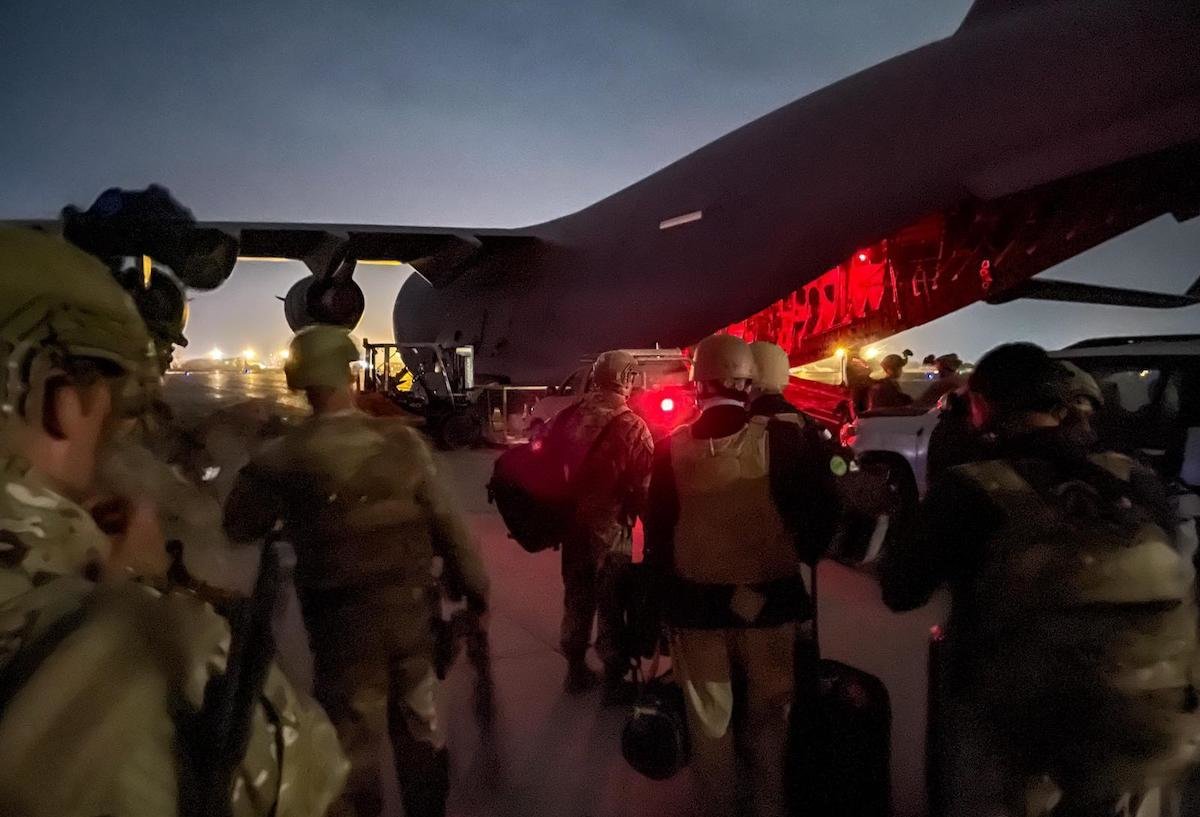The Kabul Airlift Flew 124,334 People in 778 Flights as the War’s Final Act

US troops prepare to board one of the final Air Force C-17s to depart Hamid Karzai International Airport Monday, Aug. 30, 2021. US Army photo by Master Sgt. Alexander Burnett.
The Kabul airlift evacuated 124,334 people — an exodus roughly equivalent to emptying a city the size of Hartford, Connecticut; Thousand Oaks, California; or Athens, Georgia — since mid-August, Secretary of Defense Lloyd Austin said in a press briefing Wednesday, Sept. 1. The US military has “concluded our historic evacuation operation and ended the last mission of the US war in Afghanistan,” Austin said. “America’s longest war has come to a close.”
Appearing with Chairman of the Joint Chiefs of Staff Gen. Mark Milley, Austin praised the unprecedented actions by military members in the previous two weeks in Kabul.
“Our outstanding men and women showed steady judgment under crushing pressure,” Austin said. “They ran an international airport. They sped up visas. They fed the hungry. They comforted the desperate and got plane after plane after plane into the sky.”

In all, Austin said, US forces in Kabul oversaw 778 flights out of the city during the evacuation, including 387 US military flights of primarily C-17 and C-130 transports. The Air Force’s C-17 fleet is 222 aircraft, according to a 2020 Government Accountability Office report, and in 2019 had a mission capable rate of about 82%, according to Air Force Magazine. The same GAO report puts the size of the Air Force’s C-130 fleet at more than 300 aircraft, between various models, though many of those are specifically assigned to regional roles around the world besides carrying cargo.
Notably, while the Kabul airlift is certain to join the 1940s Berlin airlift and post-Vietnam air evacuations both in sheer magnitude and in the lore of military mobility, the operation is unique in one key way: No aircraft crashed, nor were there any reported deaths or major injuries among passengers or crew during any evacuation flights. The only fatalities associated with the airlift appear to have been several Afghans who were killed in the early hours of the operation when they clung to the exterior of a C-17 as it took off from Kabul.
Also, Gen. Mark Milley tied the evacuation to the sacrifices of the 13 military members killed in the Abbey Gate suicide bombing and the US troops who died or were wounded throughout the war.

“Those 124,000, they never knew the 13 who died, and they will never know the 22 who were wounded, nor the thousands of dead and thousands of wounded who came before them,” Milley said. “But they will now live in freedom because of American blood shed on their behalf.”
Milley also had a message for veterans of the war who were struggling to process the end of it.
“These have been incredibly emotional and trying days, and indeed, years,” he said. “We are all conflicted with feelings of pain and anger, sorrow and sadness, combined with pride and resilience. There are no words that I or the secretary or the president or anyone else will ever do to bring the dead back, but we can always honor them. And one thing I am certain of: For any soldier, sailor, airman, or Marine and their family, your service mattered and was not in vain.”
He also addressed criticism that the US had worked closely with the Taliban during the evacuation.
Gen. Milley: "We don't know what the future of the Taliban is, but I can tell you from personal experience that this is a ruthless group from the past, and whether or not they change remains to be seen." pic.twitter.com/m4TpsmtO2c
— CSPAN (@cspan) September 1, 2021
“We don’t know what the future of the Taliban is, but I can tell you from personal experience that this is a ruthless group from the past, and whether or not they change remains to be seen,” Milley said. “In war, you do what you must.”
At one point, Milley was asked whether US forces would coordinate with Taliban fighters to hunt members of ISIS-K, the group behind the Abbey Gate bombing that killed 13 Americans during the evacuation, the largest single loss-of-life incident in the war in more than 10 years.
Milley hesitated and then, in a low voice, answered curtly (2:16 in the video above), “It’s possible.”
Read Next:

Matt White is a former senior editor for Coffee or Die Magazine. He was a pararescueman in the Air Force and the Alaska Air National Guard for eight years and has more than a decade of experience in daily and magazine journalism.
BRCC and Bad Moon Print Press team up for an exclusive, limited-edition T-shirt design!
BRCC partners with Team Room Design for an exclusive T-shirt release!
Thirty Seconds Out has partnered with BRCC for an exclusive shirt design invoking the God of Winter.
Lucas O'Hara of Grizzly Forge has teamed up with BRCC for a badass, exclusive Shirt Club T-shirt design featuring his most popular knife and tiomahawk.
Coffee or Die sits down with one of the graphic designers behind Black Rifle Coffee's signature look and vibe.
Biden will award the Medal of Honor to a Vietnam War Army helicopter pilot who risked his life to save a reconnaissance team from almost certain death.
Ever wonder how much Jack Mandaville would f*ck sh*t up if he went back in time? The American Revolution didn't even see him coming.
A nearly 200-year-old West Point time capsule that at first appeared to yield little more than dust contains hidden treasure, the US Military Academy said.












